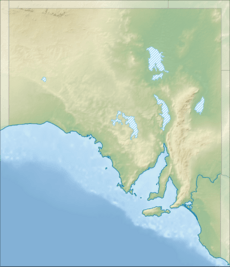The Plug Range Conservation Park facts for kids
Quick facts for kids The Plug Range Conservation ParkSouth Australia |
|
|---|---|
|
IUCN Category VI (Managed Resource Protected Area)
|
|
| Nearest town or city | Cowell |
| Established | 11 November 1993 |
| Area | 25.82 km2 (10.0 sq mi) |
| Managing authorities | Department for Environment and Water |
| See also | Protected areas of South Australia |
The Plug Range Conservation Park is a special protected area in the Australian state of South Australia. It is located on the Eyre Peninsula, about 28 kilometers north-west of the town of Cowell. This park helps to protect important plants and animals in the region.
Discover The Plug Range Conservation Park
The Plug Range Conservation Park was officially created on November 11, 1993. It was first known as The Plug Range Conservation Reserve. Later, on September 6, 2012, it became a Conservation Park. This change allows some activities like mining to happen, but the area is still carefully protected. The park gets its name from a group of hills nearby called The Plug Range.
Why The Park is Special
This park is very important because it has a lot of natural bushland. Most of the park is covered in mallee forest, which is a type of eucalyptus tree that grows with many stems from the ground. There are also woodlands with Melaleuca shrubs growing underneath the trees.
This natural environment provides a safe home for many animals and plants. It is especially important for the Malleefowl, which is a unique Australian bird.
Animals and Plants You Might See
The park is home to several important species. Besides the Malleefowl, you might also find the Gilbert’s Whistler, a small bird known for its beautiful song.
There are also rare plants like Bentham’s Goodenia and the Six-nerve Spine-bush. These plants are considered rare under the National Parks and Wildlife Act. This means they are very special and need to be protected.
How The Park is Protected
The Plug Range Conservation Park is classified as an IUCN Category VI protected area. This means it is a protected area where people can use some natural resources, but only in a way that keeps the environment healthy and safe for the future. The park is managed by the Department for Environment and Water.


